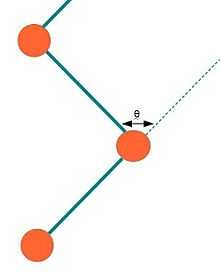Kuhn length

The Kuhn length is a theoretical treatment, developed by Werner Kuhn, in which a real polymer chain is considered as a collection of  Kuhn segments each with a Kuhn length
Kuhn segments each with a Kuhn length  . Each Kuhn segment can be thought of as if they are freely jointed with each other.[1][2][3] Each segment in a freely jointed chain can randomly orient in any direction without the influence of any forces, independent of the directions taken by other segments. Instead of considering a real chain consisting of
. Each Kuhn segment can be thought of as if they are freely jointed with each other.[1][2][3] Each segment in a freely jointed chain can randomly orient in any direction without the influence of any forces, independent of the directions taken by other segments. Instead of considering a real chain consisting of  bonds and with fixed bond angles, torsion angles, and bond lengths, Kuhn considered an equivalent ideal chain with
bonds and with fixed bond angles, torsion angles, and bond lengths, Kuhn considered an equivalent ideal chain with  connected segments, now called Kuhn segments, that can orient in any random direction.
connected segments, now called Kuhn segments, that can orient in any random direction.
The length of a fully stretched chain is  for the Kuhn segment chain.[4] In the simplest treatment, such a chain follows the random walk model, where each step taken in a random direction is independent of the directions taken in the previous steps, forming a random coil. The average end-to-end distance for a chain satisfying the random walk model is
for the Kuhn segment chain.[4] In the simplest treatment, such a chain follows the random walk model, where each step taken in a random direction is independent of the directions taken in the previous steps, forming a random coil. The average end-to-end distance for a chain satisfying the random walk model is  .
.
Since the space occupied by a segment in the polymer chain cannot be taken by another segment, a self-avoiding random walk model can also be used. The Kuhn segment construction is useful in that it allows complicated polymers to be treated with simplified models as either a random walk or a self-avoiding walk, which can simplify the treatment considerably.
For an actual homopolymer chain (consists of the same repeat units) with bond length  and bond angle θ with a dihedral angle energy potential, the average end-to-end distance can be obtained as
and bond angle θ with a dihedral angle energy potential, the average end-to-end distance can be obtained as
 ,
,
- where
 is the average cosine of the dihedral angle.
is the average cosine of the dihedral angle.
- where
The fully stretched length  . By equating
. By equating  and
and  for the actual chain and the equivalent chain with Kuhn segments, the number of Kuhn segments
for the actual chain and the equivalent chain with Kuhn segments, the number of Kuhn segments  and the Kuhn segment length
and the Kuhn segment length  can be obtained.
can be obtained.
For worm-like chain, Kuhn length equals two times the persistence length.[5]
References
- ↑ Flory, P.J. (1953) Principles of Polymer Chemistry, Cornell Univ. Press, ISBN 0-8014-0134-8
- ↑ Flory, P.J. (1969) Statistical Mechanics of Chain Molecules, Wiley, ISBN 0-470-26495-0; reissued 1989, ISBN 1-56990-019-1
- ↑ Rubinstein, M., Colby, R. H. (2003)Polymer Physics, Oxford University Press, ISBN 0-19-852059-X
- ↑ Michael Cross (October 2006), Physics 127a: Class Notes; Lecture 8: Polymers, California Institute of Technology, retrieved 2013-02-20
- ↑ Gert R. Strobl (2007) The physics of polymers: concepts for understanding their structures and behavior, Springer, ISBN 3-540-25278-9